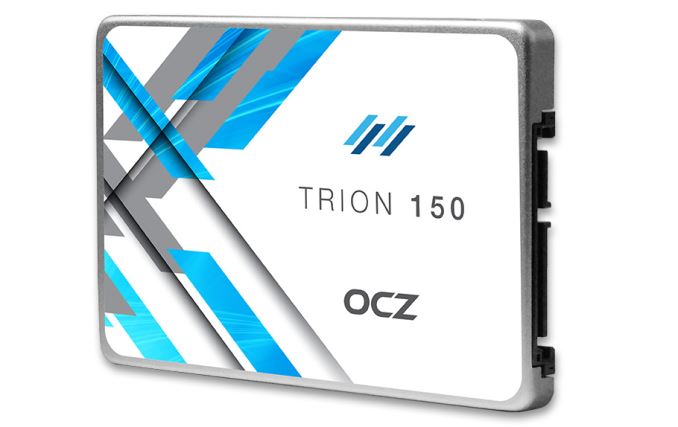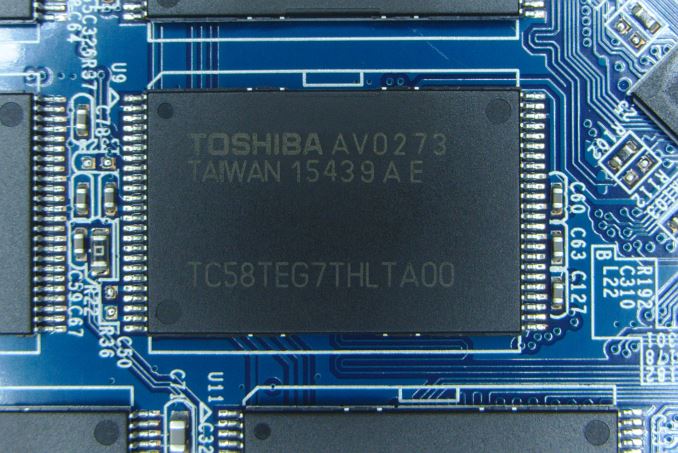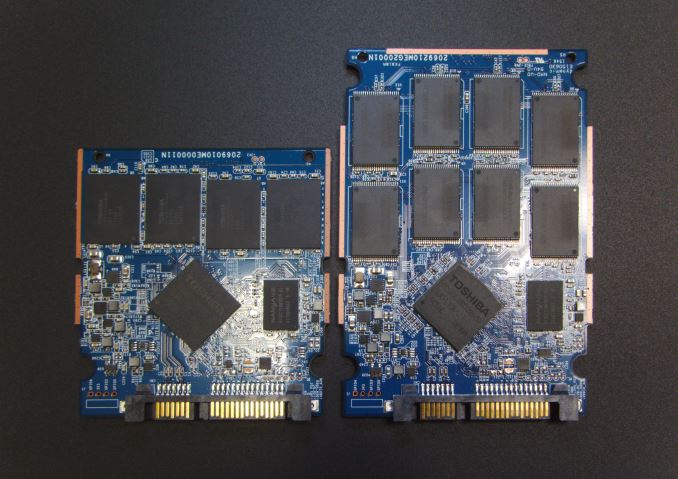The OCZ Trion 150 SSD Review
by Billy Tallis on April 1, 2016 8:00 AM EST
Last year's OCZ Trion 100 was the first drive released by OCZ as a subsidiary of Toshiba, and was really more of a Toshiba product that was released under the OCZ brand. As a prime opportunity to reestablish the OCZ brand post-bankruptcy, the Trion 100 was initially disappointing for its poor performance. It has since become clear that the Trion 100 was merely an early entrant in a race to the bottom that has seen sub-20nm planar TLC used to drive price down as much as possible even at the cost of performance.
While the price of MLC-based drives has also been declining, the new class of low-end TLC drives has made SSDs far more accessible by trading some performance for capacity. Most manufacturers are very explicit about marketing these SSDs for upgrades from hard drives rather than from earlier and smaller and more expensive SSDs, but it's hard not to make those comparisons. It's important to keep in mind that for the cheapest SSDs on the market, maximizing performance is not the only goal and often isn't even a primary goal.
Today we're taking a look at the successor to the Trion 100, the Trion 150. On paper, the OCZ Trion 150 looks like a fairly uninteresting update. The flash is changed from Toshiba's A19nm TLC to their 15nm TLC, which is cause for concern about how the smaller flash memory cells might hurt performance and endurance. The Trion is still using Toshiba's TC58NC1010 controller, a custom branded variant of Phison's S10. The performance specifications of the Trion 150 are unchanged from the Trion 100, but OCZ has made non-specific claims about performance improving for things like sustained performance. For that to be possible with what would seem to be a disadvantageous die shrink of the flash, the drive's firmware needs to be much better than the Trion 100's.
| OCZ Trion 150 Specifications | ||||||
| Capacity | 120GB | 240GB | 480GB | 960GB | ||
| Controller | Toshiba TC58NC1000 (Phison S10) | |||||
| NAND | Toshiba 15nm TLC | |||||
| Sequential Read | 550MB/s | 550MB/s | 550MB/s | 550MB/s | ||
| Sequential Write | 450MB/s | 520MB/s | 530MB/s | 530MB/s | ||
| 4KB Random Read | 79K IOPS | 90K IOPS | 90K IOPS | 90K IOPS | ||
| 4KB Random Write | 25K IOPS | 43K IOPS | 54K IOPS | 64K IOPS | ||
| Endurance | 30TB | 60TB | 120TB | 240TB | ||
| DevSleep Power | 6mW | |||||
| Idle Power | 830mW | |||||
| Max Power | 4.8W | |||||
| Warranty | Three years | |||||
| Price (Amazon) | $45.99 | $61.99 | $117.49 | $229.99 | ||
Externally the Trion 150 is very similar to the Trion 100: the casing is identical and the labeling is only slightly changed. Opening things up we immediately see that more has changed than just the NAND flash dies. The flash is now in 16 TSOP packages rather than 4 BGA packages, requiring a much larger PCB but allowing for much cheaper packaging. The layout of the PCB around the controller and DRAM is similar to the Trion 100, but there's now a thermal pad between the controller and the case.
As the successor to the Trion 100, the Trion 150 will be OCZ and Toshiba's entry-level SSD and will compete against the drives with the lowest price per gigabyte, now hovering around 20¢/GB. The primary competitors and points of comparison will be other drives with 15/16nm TLC such as ADATA's Premier SP550 and Crucial's BX200 (both using Silicon Motion's SM2256 controller) and drives from many brands using the Phison S10 platform and Toshiba TLC.
| AnandTech 2015 SSD Test System | |
| CPU | Intel Core i7-4770K running at 3.5GHz (Turbo & EIST enabled, C-states disabled) |
| Motherboard | ASUS Z97 Deluxe (BIOS 2501) |
| Chipset | Intel Z97 |
| Memory | Corsair Vengeance DDR3-1866 2x8GB (9-10-9-27 2T) |
| Graphics | Intel HD Graphics 4600 |
| Desktop Resolution | 1920 x 1200 |
| OS | Windows 8.1 x64 |
- Thanks to Intel for the Core i7-4770K CPU
- Thanks to ASUS for the Z97 Deluxe motherboard
- Thanks to Corsair for the Vengeance 16GB DDR3-1866 DRAM kit, RM750 power supply, Carbide 200R case, and Hydro H60 CPU cooler
















79 Comments
View All Comments
ocztaec - Tuesday, April 5, 2016 - link
Hi Arnulf,As this is my first post on this article please allow me to identify myself as a Toshiba America Electronic Components (TAEC) representative. We completely understand the quality concerns and appreciate your comments. Since the Toshiba acquisition of OCZ in 2014 improving product reliability is a key priority for us. We made significant changes to everything from processes to production. OCZ SSDs are made with premium Toshiba NAND and is back by the Advanced Warranty Program.
We understand how you feel and hope that one day we will have the opportunity to demonstrate the reliability of current OCZ products. Thank you again for your feedback.
nathanddrews - Friday, April 1, 2016 - link
Not a great showing, that's for sure. I'd like to point out two things - one is that we're looking at a range of drives that could be offering 2TB SSDs for under $400. WhereTF are they? I feel like we've been pretty patient, but at these prices, I can actually afford to replace all disks on my PCs and getting really close to replacing disks on my servers and NAS units.Second, would it be at all reasonable to add a WD VelociRaptor, Hybrid SSHD, and/or common 5400RPM hard drive to the 2015 SSD Bench like the old days? I think most of the readership knows how much better ANY SSD is over a mechanical HDD, but I think we also get a bit too cynical with drives like this that are "slow" compared to other SSDs and won't even consider buying them. We shouldn't forget where we came from. XD
tarqsharq - Friday, April 1, 2016 - link
I second this, really want to keep perspective on speeds, especially when we're dealing with the low cost SSDs where you can get high storage space for low $$ImSpartacus - Saturday, April 2, 2016 - link
Yeah, it would a fantastic way to gain context. Just don't worry about scaling the graphs for the hard drives if that ever becomes an issue.bug77 - Friday, April 1, 2016 - link
Have you seen the size increase of the PCB? There's no space for 2TB worth of chips.DanNeely - Friday, April 1, 2016 - link
Agreed, as stated in the 2nd paragraph of the article: "It's important to keep in mind that for the cheapest SSDs on the market, maximizing performance is not the only goal and often isn't even a primary goal." Yes, the performance sucks compared to anything the average Anandtech reader would put in his computer, but these drives are intended to get people who buy cheap crappy computers at the boxmark off of spinning rust. It might help if the performance charts were split between performance and budget SSDs, otherwise is as unfair as comparing a standard HDD to a 15k SAS drive would've been a dozen years ago.It's still probably 2 or 3 generations before I'd consider SSDing my NAS. Pricing even on cheap SSDs is still ~6x that of NAS HDDs; it'd need to drop to at most 2x before I'd consider it; at that point reduced power consumption over a half dozen years might be able to close enough of the gap that quieter operation and smaller size might be worth the larger up front cost. Also, I'd want at least 6gb of post RAID storage capacity if standing up a new NAS today; probably 10 or 12 if I'd be filling all the bays and unable to add more storage to it later; with my needs growing by about 2x every 3-4 years. The smaller criteria could be met by 4x2gb drives in raid 5; the latter would either need 4gb drives or an 8 bay enclosure. Pre-built 8-bay NASes suffer from an additional enterprise price premium; while on the DIY front that many sata ports is stretching what can be done with cheap hardware and I'm not aware of any mITX sized cases with that many drive bays.
bji - Friday, April 1, 2016 - link
Just curious, what do you do with all that storage? 10 to 12 TB (I assume your 6gb was a typo and you meant 6tb) is a hell of alot of storage. What do you need so much storage for?I am still using a first gen Macbook pro retina with 256 GB of SSD storage and I have 90 GB free. Even my server that does backups and stuff uses only about 350 GB.
DanNeely - Friday, April 1, 2016 - link
Media and system backups. About half of the latter is images of old systems that I got rid of at some point. Feeding bigger drives into the nas is a lot easier than trying to scour a system to make sure everything of value's been removed separately. Most recently some scanned documents a family member left in the scanner apps temp folder (that I didn't even know existed).bji - Friday, April 1, 2016 - link
What kind of media needs that much storage? Are you a professional videographer?Arnulf - Saturday, April 2, 2016 - link
P0rn :)